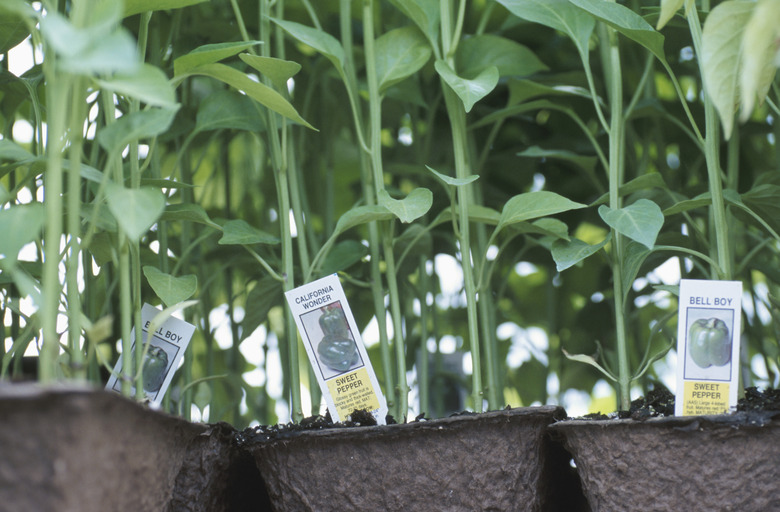Care Of An Ornamental Pepper Plant
The same species as bell peppers and chili peppers, ornamental peppers (Capsicum annuum) are usually compact plants that grow 12 inches tall and wide. They produce tiny peppers that often grow upwards. The peppers mature from green to yellow, orange and red, creating a profusion of color on the bright green plants. Some varieties have white, black or purple fruits.
Planting
Step 1
Native to Central and South America, ornamental pepper plants don't tolerate even a hint of frost. Wait to plant them outdoors until the last expected frost or grow them indoors as houseplants. You can buy them as seedlings or sow your own seeds. Sow seeds in a seed flat filled with a light starting mix. Keep the seeds moist and maintain temperatures between 75 and 80 degrees Fahrenheit until the seedlings germinate. Ornamental peppers tolerate most soil types but grow best in well-draining loam. Use a high-quality potting mix in pots and amend garden soils with compost or manure.
- The same species as bell peppers and chili peppers, ornamental peppers (Capsicum annuum) are usually compact plants that grow 12 inches tall and wide.
- The peppers mature from green to yellow, orange and red, creating a profusion of color on the bright green plants.
Growing Conditions
Step 1
Whether grown indoors or out, ornamental peppers need bright sun to produce fruit. In shade, they become spindly and unproductive. Choose a spot that gets at least six to eight hours of sun daily for best growth. Ornamental peppers don't need as much fertilizer as edible peppers, but they do benefit from it. Dig 4 to 6 cups granular 10-10-10 fertilizer into the garden for each 100 square feet of soil before planting peppers. Houseplants can be fertilized every three to six weeks with 1 tablespoon granular 10-10-10 fertilizer diluted in 1 gallon of water. Follow the rates on the fertilizer's package. Ornamental peppers also need consistent water. In the garden, water them so the soil stays moist 1 inch beneath the surface. Water potted plants as soon as the surface feels slightly dry. Avoid soggy, waterlogged soil, which can contribute to root rot.
- Whether grown indoors or out, ornamental peppers need bright sun to produce fruit.
Time Frame
Step 1
Although ornamental peppers are perennials in U.S. Department of Agriculture plant hardiness zones 9b through 11, they're generally grown as annuals. They typically produce fruit 60 days after planting and die with the first frost. Indoors, houseplants produce fruit for four to six weeks and then tend to die because there isn't enough sunlight.
Uses
Step 1
Ornamental peppers work well as container plants, either in the house or on the patio, or in an ornamental garden setting. Plant them among perennials and annuals, or tuck them into your vegetable garden. The tiny, upright peppers are edible, but they're incredibly hot. Eating one whole can cause stomach upset and diarrhea, although they can be used in small amounts to flavor curries or Mexican dishes. You can also dry and grind ornamental peppers to make chili powder.
- Although ornamental peppers are perennials in U.S. Department of Agriculture plant hardiness zones 9b through 11, they're generally grown as annuals.
- Eating one whole can cause stomach upset and diarrhea, although they can be used in small amounts to flavor curries or Mexican dishes.
Pests and Diseases
Step 1
Ornamental peppers are usually healthy, vigorous plants with few insect pests or disease problems. Occasionally, they may suffer from aphid or spider mite infestations. Vanquish these pests with a steady stream of water or spray the leaves liberally with a ready-to-use insecticidal soap. Cucumber mosaic virus is a serious disease that causes mottled leaves and stunted growth. Once infected, plants usually perish. The disease can be spread by aphids so controlling them and rotating crops is the best control. Root rots cause blackened stems and roots and eventual plant death. To prevent this problem, start with healthy plants, provide well-draining soil and avoid over-watering.
- Ornamental peppers are usually healthy, vigorous plants with few insect pests or disease problems.
- The disease can be spread by aphids so controlling them and rotating crops is the best control.
